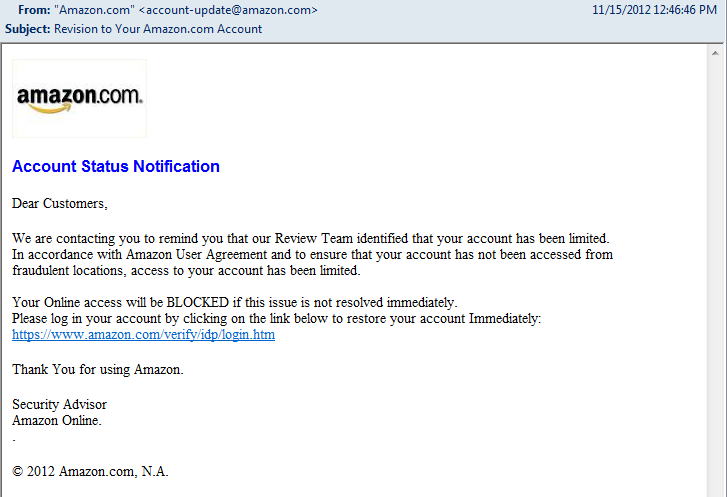Action Fraud (a cyber crime reporting organisation), report that individuals and businesses lost over $25m during the Christmas period 2014 through online fraud.
So what can you do to protect yourself? Well, be aware. In this piece I’ve set out a few examples of how criminals may attempt to steal from you online, and how to spot and avoid them.
Look out for fake websites
Criminals are making replicas of genuine websites, “selling” products that never turn up. Mobile phones are the most common product to be scammed in this way.
How to spot it:
- Do they have an address and phone number? Google it and ring them up.
- Check the URL to be sure it is the correct name for the retailer. On the payment page it should be secure – check for a padlock in the search bar.
Beware of “Phishing” Emails
These are emails that appear to be from familiar companies (e.g. Amazon, Apple) or retailers you have accounts with. They can be very convincing – take a look at the picture below purported to be from Amazon.

Clicking on embedded links or attachments in emails like this can lead you to malicious websites that could track your online activity and access passwords. Alternatively you could end up on a fake website which asks for your details.
How to spot it:
- Legitimate retailers won’t ask for your bank information or passwords in an email
- Generic way of addressing you (“Dear Customers” above)
- Strange email addresses, spelling mistakes, bad grammar
What to do:
- Mark it as spam or junk
- Do not click on any links, nor download any attachments
- If you were expecting something from the retailer but you’re not certain this is it, contact them independently through their website or by telephone
Does it seem too good to be true?
Have you just received a $250 voucher by email? Maybe there’s a free offer on Facebook – for example have you seen those Ray Ban Sunglasses “deals”?
And be on the lookout for pyramid schemes – they are still around believe it or not. Typically something like send $10 to a friend and receive dozens of gifts in return.
How to spot it:
- It’s unlikely your real Facebook friends will want to get you a deal on Ray Ban sunglasses
What to do:
- Don’t click
- Check what Apps you’re subscribed to and remove all but the ones you know and trust
As in all things – if it seems too good to be true – IT IS!
Happy shopping…!
